North Korea fires second ballistic missile over Japan
- Posted on
- Comment
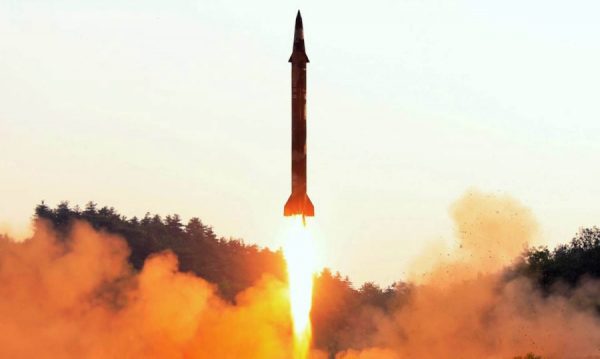 North Korea has fired a ballistic missile across Japan, creating new tension in the region after its nuclear bomb test less than two weeks ago.
North Korea has fired a ballistic missile across Japan, creating new tension in the region after its nuclear bomb test less than two weeks ago.
The missile reached an altitude of about 770km (478 miles), travelling 3,700km before landing in the sea off Hokkaido, South Korea’s military says.
It flew higher and further than one fired over Japan late last month.
Japanese Prime Minister Shinzo Abe said his country would “never tolerate” such “dangerous provocative action”.
South Korea responded within minutes by firing two ballistic missiles into the sea in a simulated strike on the North.
US Secretary of State Rex Tillerson also condemned the launch and the UN Security Council will meet later on Friday in New York at the request of America and Japan.
Why does this new test matter?
The launch took place from the Sunan airfield north of Pyongyang just before 07:00 local time (22:00 GMT on Thursday), South Korea’s military says.
As with the last test on 29 August, the missile flew over Japan’s northern Hokkaido island before splashing down in the Pacific Ocean. There were no immediate reports of damage to aircraft or ships.
Sirens sounded across the region and text message alerts were sent out warning people to take cover.
| Comparison of missile launches over Japan | ||
|---|---|---|
| 15 September | 29 August | |
| Distance travelled | 3,700km (2,299 miles) | 2,700km |
| Maximum altitude | 770km | 550km |
| Landing distance from Japan | 2,200km | 1,180km |
| Flight duration | 19 minutes | 32 minutes |
| Missile type | Thought to be intermediate range missile | Thought to be intermediate range Hwasong-12 |
Observers say it is likely to have been an intermediate range ballistic missile (IRBM) though Japanese officials believe there is still a possibility it was an intercontinental ballistic missile (ICBM).
What is so alarming about the new launch is that the US Pacific territory of Guam, which North Korea says it has plans to fire missiles towards, is 3,400km from Pyongyang, putting it within range of the latest missile.
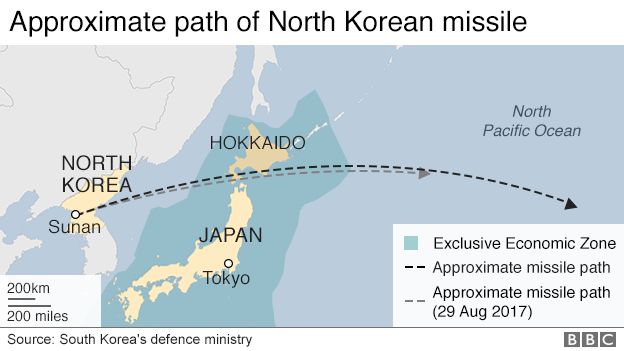
Sanctions on the North were tightened this week in response to its sixth nuclear test on 3 September, which reportedly involved a miniaturised hydrogen bomb that could be loaded on to a long-range missile.
How will the international community respond?
After the latest round of sanctions, it is not clear what other course of action is open to the UN Security Council.
Only on Monday, the Security Council voted unanimously to restrict oil imports and ban textile exprots, in an attempt to starve the North of fuel and income for its weapons programmes.
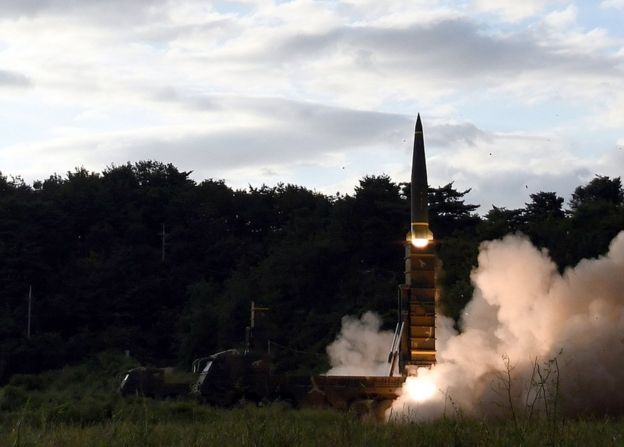 Image copyrightEPA
Image copyrightEPAMr Tillerson put the burden of response to the latest test on China and Russia, the North’s main economic partners.
They “must indicate their intolerance for these reckless missile launches by taking direct actions of their own”, he said.
Nato chief Jens Stoltenberg described the missile launch as “another reckless breach of UN resolutions” and a “major threat to international peace and security which demands a global response”.
In South Korea, President Moon Jae-in held an emergency meeting of his national security council, where he said that dialogue with the North was “impossible in a situation like this”.
Officials have been ordered to prepare for possible North Korean chemical, biological and electromagnetic pulse attacks, a presidential spokesman said.
Why is the North acting like this?
It insists it needs a nuclear-weapons programme to ensure its survival and there has been no let-up in its fiery rhetoric.
On Thursday, it threatened to “sink Japan and turn America to ashes”.
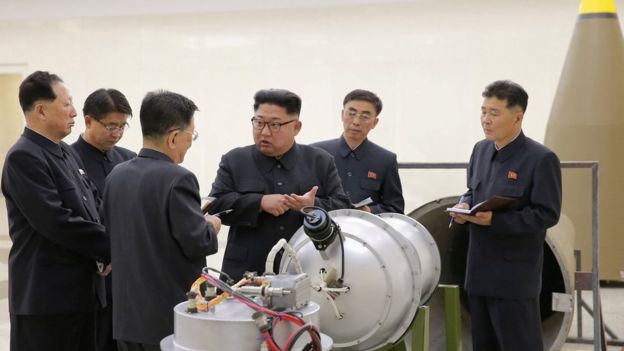 Image copyrightREUTERS/KCNA
Image copyrightREUTERS/KCNANorth Korea’s missile programme
Pushing the envelope
Rupert Wingfield-Hayes, BBC News, Tokyo
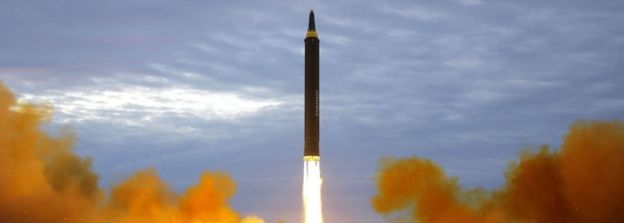 Image copyrightKCNA
Image copyrightKCNAThis test came as a surprise to nobody.
North Korea is steadily proceeding down the path to full ICBM capability. To do that, it needs to test-fire its projectiles – every other missile-armed nation has done the same.
It started earlier this year by firing its new longer-range Hwasong missiles into the Sea of Japan, then flew one over Hokkaido in August. Next it tested a powerful nuclear device, which it claims it can put on a missile.
Now it has tested another intermediate range missile at longer range and higher altitude.
The next step will almost certainly be a test of the Hwasong-14 ICBM over Japan and far out into the Pacific.
The aim of all this is to develop and deploy a reliable missile that can hit the mainland US.
-BBC










 (Selorm) |
(Selorm) |  (Nana Kwesi)
(Nana Kwesi)